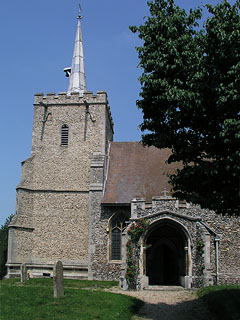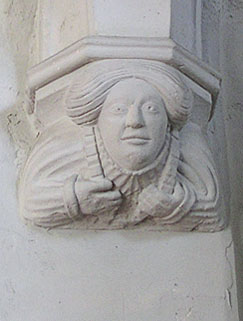In this bit of the world, they seem to like steeples that look like upturned ice-cream cones. There are ones at both Duxford churches, just downriver, and also at Great Abington. This one is only about six feet higher than that at Duxford St Peter, but this is marked as a steeple on the OS map, whereas Duxford is only a tower.
Presumably the threshold comes somewhere in those six feet, or am I assuming too much consistency in our esteemed mapping agency? Anyhow, it's a slightly silly steeple. I've never seen the point in them - no pun intended - but perhaps that's because most of the ones you see in Cambridgeshire and the rest of East Anglia are Victorian affairs, often just in wood and metal. The 14th century steeple at Landbeach is very handsome. Maybe I need to go and visit Northamptonshire...
The porch at Hinxton was covered in deep red roses on the day we visited. It's a nice enough porch, though the proportions are disturbed by its being almost swallowed by the huge south aisle. Within is a good oak door, silvery with age. Inside, the church show signs of age - there is a filled-in Norman doorway on the north wall - but the windows are almost all Perpendicular, and the church is very light by comparison with most of the others in the area. The south aisle is indeed splendid. Big angels sit on the arches leading into it from the rest of the church - Mark commented that they looked very municipal - 'like mayors of small towns clutching their chains of office'.
The nave was filled with colour from the many-coloured kneelers propped up on the benches. The Victorian screen is inoffensive, and it sits on an original base with squints where the worshippers could peek through while kneeling. The rood stair is big, which suggests that there was a good loft here. Bits of nice old glass survive here and there in the nave, but my favourite bit was under the tower (we couldn't get close because the space is now taken up by a parish room, which was locked, but we could look through the glazed partitions). This is only a couple of years old - their Millennium Window - and it depicts a fish, a bird and a rose. I've seen some dreadful 21st century glass (at Soham, for example), but this is lovely.
[Mark adds: In December 2004 Virginia Walker (secretary of the Millennium Committee that commissioned the window) kindly emailed us with the following details of the artist and subject matter:
"We decided that we would like to have represented all the topographical features of the village; therefore, the fish is a trout, which still swim in the River Cam or Granta nearby, the bird is a partridge, as Hinxton was famous for its partridge shooting (based at Hinxton Hall), the flower is a poppy, as Hinxton has had an exceptionally strong British Legion association (and still regularly wins the prize for the largest 'Poppy Appeal' collection per capita in the county). Also depicted is barley which has been grown locally over centuries, and willow leaves from the willows that grow alongside the river, and of course the river itself. The stained glass artist was Glenn Carter, based in Lincolnshire."
I do like it when people put such thought into things. When we go back we will take up her kind offer to let us get a closer look at it.]
SS John & Mary was open when we visited

